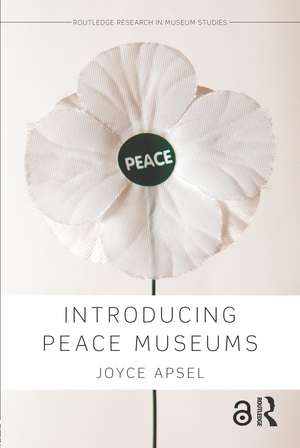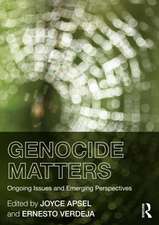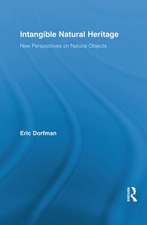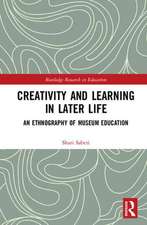Introducing Peace Museums: Routledge Research in Museum Studies
Autor Joyce Apselen Limba Engleză Paperback – 22 dec 2017
This volume examines peace museums, a small and important (but often overlooked) series of museums whose numbers have multiplied world-wide in recent decades. They relate stories and display artifacts—banners, diaries, and posters for example about such themes as: art and peace, antiwar histories, protest, peacekeeping and social justice and promote cultures of peace. This book introduces their different approaches from Japan, which has the largest number of sites, to Bradford, UK and Guernica, Spain. Some peace museums and centers emphasize popular peace symbols and figures, others provide alternative narratives about conscientious objection or civil disobedience, and still others are sites of persuasion, challenging the status quo about issues of war, peace, disarmament, and related issues.
Introducing Peace Museums distinguishes between different types of museums that are linked to peace in name, theme or purpose and discusses the debates which surround peace museums versus museums for peace. This book is the first of its kind to critically evaluate the exhibits and activities of this group of museums, and to consider the need for a "critical peace museum studies" which analyses their varied emphasis and content. The work of an experienced specialist, this welcome introduction to peace museums considers the challenges and opportunities faced by these institutions now and in the future.
| Toate formatele și edițiile | Preț | Express |
|---|---|---|
| Paperback (1) | 355.90 lei 43-57 zile | |
| Taylor & Francis – 22 dec 2017 | 355.90 lei 43-57 zile | |
| Hardback (1) | 1060.25 lei 43-57 zile | |
| Taylor & Francis – 14 dec 2015 | 1060.25 lei 43-57 zile |
Din seria Routledge Research in Museum Studies
-
 Preț: 311.48 lei
Preț: 311.48 lei -
 Preț: 311.41 lei
Preț: 311.41 lei -
 Preț: 311.41 lei
Preț: 311.41 lei -
 Preț: 312.12 lei
Preț: 312.12 lei -
 Preț: 310.16 lei
Preț: 310.16 lei -
 Preț: 311.41 lei
Preț: 311.41 lei -
 Preț: 311.09 lei
Preț: 311.09 lei -
 Preț: 311.91 lei
Preț: 311.91 lei -
 Preț: 294.20 lei
Preț: 294.20 lei -
 Preț: 326.62 lei
Preț: 326.62 lei - 25%
 Preț: 768.36 lei
Preț: 768.36 lei - 18%
 Preț: 1000.27 lei
Preț: 1000.27 lei - 25%
 Preț: 852.53 lei
Preț: 852.53 lei - 18%
 Preț: 1057.89 lei
Preț: 1057.89 lei - 31%
 Preț: 763.00 lei
Preț: 763.00 lei -
 Preț: 469.34 lei
Preț: 469.34 lei -
 Preț: 411.42 lei
Preț: 411.42 lei - 18%
 Preț: 1000.27 lei
Preț: 1000.27 lei -
 Preț: 387.75 lei
Preț: 387.75 lei - 18%
 Preț: 1000.27 lei
Preț: 1000.27 lei -
 Preț: 387.96 lei
Preț: 387.96 lei -
 Preț: 488.71 lei
Preț: 488.71 lei -
 Preț: 483.55 lei
Preț: 483.55 lei -
 Preț: 382.49 lei
Preț: 382.49 lei - 20%
 Preț: 259.31 lei
Preț: 259.31 lei - 25%
 Preț: 767.07 lei
Preț: 767.07 lei - 18%
 Preț: 998.83 lei
Preț: 998.83 lei - 18%
 Preț: 1000.76 lei
Preț: 1000.76 lei - 18%
 Preț: 1000.27 lei
Preț: 1000.27 lei - 18%
 Preț: 1067.14 lei
Preț: 1067.14 lei - 25%
 Preț: 852.38 lei
Preț: 852.38 lei - 18%
 Preț: 1060.25 lei
Preț: 1060.25 lei -
 Preț: 380.25 lei
Preț: 380.25 lei -
 Preț: 384.48 lei
Preț: 384.48 lei -
 Preț: 382.95 lei
Preț: 382.95 lei -
 Preț: 288.81 lei
Preț: 288.81 lei - 31%
 Preț: 760.54 lei
Preț: 760.54 lei
Preț: 355.90 lei
Nou
Puncte Express: 534
Preț estimativ în valută:
68.12€ • 74.02$ • 57.26£
68.12€ • 74.02$ • 57.26£
Carte tipărită la comandă
Livrare economică 21 aprilie-05 mai
Preluare comenzi: 021 569.72.76
Specificații
ISBN-13: 9780815346296
ISBN-10: 0815346298
Pagini: 236
Dimensiuni: 156 x 234 x 13 mm
Greutate: 0.44 kg
Ediția:1
Editura: Taylor & Francis
Colecția Routledge
Seria Routledge Research in Museum Studies
Locul publicării:Oxford, United Kingdom
ISBN-10: 0815346298
Pagini: 236
Dimensiuni: 156 x 234 x 13 mm
Greutate: 0.44 kg
Ediția:1
Editura: Taylor & Francis
Colecția Routledge
Seria Routledge Research in Museum Studies
Locul publicării:Oxford, United Kingdom
Public țintă
Postgraduate and UndergraduateCuprins
1. Introducing Peace Museums: Peace Matters
2. The Peace Museum in Bradford, UK: Fostering Peace Education and Community Cohesion While Preserving Peace Art and History
3. Kyoto Museum for World Peace: Speaking Truth to Power: A University Peace Museum
4. Gernika Peace Museum: Creating a Culture of Peace and Reconciliation
5. Dayton International Peace Museum: A Community Model
6. The Nobel Peace Center, Oslo, and Casa per la Pace, Casalecchio di Reno, Bologna, Italy
Individuals and Movements for Peace and Pacifism
7.Conclusion: Peace Museums Looking Forward
2. The Peace Museum in Bradford, UK: Fostering Peace Education and Community Cohesion While Preserving Peace Art and History
3. Kyoto Museum for World Peace: Speaking Truth to Power: A University Peace Museum
4. Gernika Peace Museum: Creating a Culture of Peace and Reconciliation
5. Dayton International Peace Museum: A Community Model
6. The Nobel Peace Center, Oslo, and Casa per la Pace, Casalecchio di Reno, Bologna, Italy
Individuals and Movements for Peace and Pacifism
7.Conclusion: Peace Museums Looking Forward
Recenzii
"In Introducing Peace Museums, Joyce Apsel has captured the philosophies and practice of a dynamic but little-documented heritage phenomenon that not only reclaims and preserves memory but actively promotes social change. . . . Introducing Peace Museums is a treasure for scholars, museum professionals as well as general interested readers alike. It is a unique and much-needed volume reflecting both an eye for detail and the ability to observe and understand the wider peace movement and its social and cultural significance."
Clive Barrett, University of Leeds, UK, and Chair of the Peace Museum, Bradford, UK
"Apsel’s book pays homage to those individuals and institutions engaged in positive peacebuilding, an ongoing process evolving over time. . . . It gives voice to those altruistic individuals and institutions who strove in the past and who live and strive today to ‘make peace.’"
Siegrid Raible, PASOS Peace Museum, USA
"Joyce Apsel’s Introducing Peace Museums is thus a timely and welcome presentation of a kind of museum that is still largely unknown and yet vitally important in opening up the debate about war and peace. . . . She has conceived of her study as 'A Peace Museum Sampler' which describes and analyzes four museums (two from Europe and one each from the United States and Japan) as well as two peace centers (both in Europe) which can also be regarded as museums. Many other peace museums are briefly introduced along the way. . . . Her book is all the more welcome as it is the first book-length study of its kind."
Peter van den Dungen, Bradford University, UK, and General Coordinator of the International Network of Museums for Peace
(Memory Studies, October 2016)
"Introducing Peace Museums is precisely what this clearly written and informative book by Joyce Apsel does. . . . The book is an ambitious attempt to examine peace museums in a global context. Introducing Peace Museums will serve as a useful introduction, especially to readers unfamiliar with the concept, educators who want to incorporate peace museums into their curriculum, and curators who are interested in expanding the scope of their museums to include displays on peace. Each chapter can also function as a preliminary guidebook for readers who wish to visit the museums introduced."
Akiko Takenaka, University of Kentucky, USA, and co-author of Exhibiting World War II in Japan and the US since 1995.
(The Public Historian, August 2016)
Clive Barrett, University of Leeds, UK, and Chair of the Peace Museum, Bradford, UK
"Apsel’s book pays homage to those individuals and institutions engaged in positive peacebuilding, an ongoing process evolving over time. . . . It gives voice to those altruistic individuals and institutions who strove in the past and who live and strive today to ‘make peace.’"
Siegrid Raible, PASOS Peace Museum, USA
"Joyce Apsel’s Introducing Peace Museums is thus a timely and welcome presentation of a kind of museum that is still largely unknown and yet vitally important in opening up the debate about war and peace. . . . She has conceived of her study as 'A Peace Museum Sampler' which describes and analyzes four museums (two from Europe and one each from the United States and Japan) as well as two peace centers (both in Europe) which can also be regarded as museums. Many other peace museums are briefly introduced along the way. . . . Her book is all the more welcome as it is the first book-length study of its kind."
Peter van den Dungen, Bradford University, UK, and General Coordinator of the International Network of Museums for Peace
(Memory Studies, October 2016)
"Introducing Peace Museums is precisely what this clearly written and informative book by Joyce Apsel does. . . . The book is an ambitious attempt to examine peace museums in a global context. Introducing Peace Museums will serve as a useful introduction, especially to readers unfamiliar with the concept, educators who want to incorporate peace museums into their curriculum, and curators who are interested in expanding the scope of their museums to include displays on peace. Each chapter can also function as a preliminary guidebook for readers who wish to visit the museums introduced."
Akiko Takenaka, University of Kentucky, USA, and co-author of Exhibiting World War II in Japan and the US since 1995.
(The Public Historian, August 2016)
Descriere
This volume examines peace museums, a small and important (but often overlooked) series of museums whose numbers have multiplied internationally since the 1970s. It introduces the history and significance of peace museums and their different approaches through a selected series of peace museum sites. It attempts to categorize and distinguish between different types of museums that are linked to peace in name, theme or purpose and to urge a "critical peace museums studies" in examining their varied emphasis and content.










